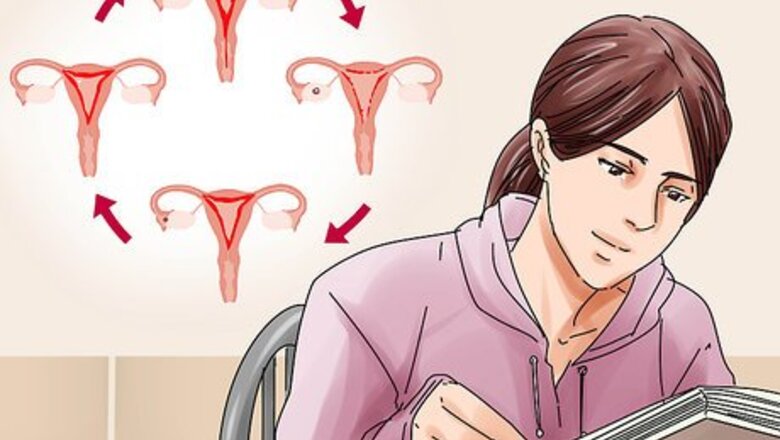
views
Explaining the Process of Menstruation
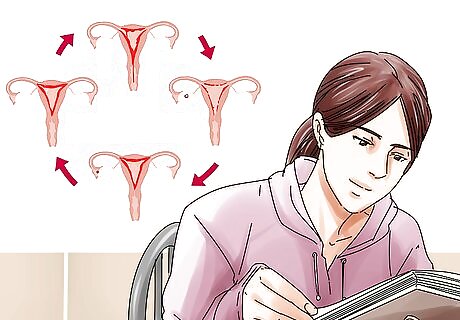
Increase your own knowledge about menstruation. It’s hard to explain things to kids when you don't understand them yourself. Prior to having a discussion for children of any age, review information about menstrual cycles. Read materials written specifically for kids. You can also review diagrams of the female reproductive system and include diagrams in your explanation. The more comfortable you feel in your knowledge, the easier your explanation will be. You may want to check out a book on menstruation written specifically for children or share it with your kid(s).
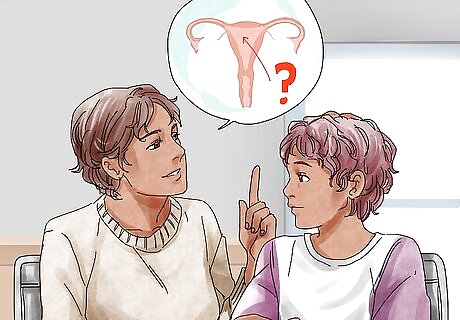
Discuss the function of the uterus. If the kid you're speaking with already has an understanding of where babies come from, this part will be easy. If not, it might be a longer conversation. Explain to the kid that a lot of people, mostly women, have a “baby center” called the uterus, which allows them to grow a baby. Each month, the body gets ready to hold a new baby. To do this, the uterus has to get extra strong, so it grows a lining. For example, a mother might say to her young son, "Some people a uterus, which is where babies grow until they are ready to come out. Every month, their body gets ready to have another baby and the lining of uterus gets really thick so that it can catch an egg and hold on to it. If it's time to have a baby, the baby will grow inside the uterus." If the child is having trouble understanding the concept, you might say the uterus is like a balloon inside the tummy. By age 5, children should be comfortable with the official names of reproductive organs.
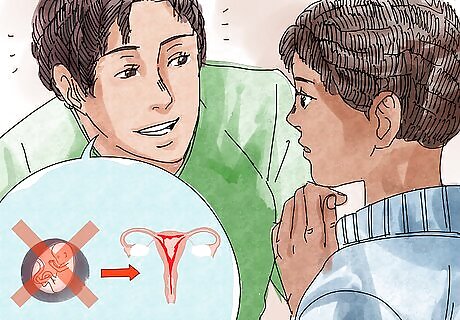
Explain that bleeding occurs when there is no baby. If a person doesn’t have a baby inside, the uterus no longer needs the thickened lining created that month. The lining dissolves and is dispelled through the vagina. The mother could continue with something like, “If a person doesn’t want to have another baby, this extra strong lining in the uterus goes away because it isn't needed. That lining leaves the body through the vagina.”
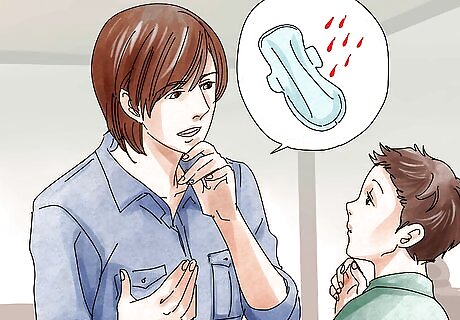
Talk about menstrual products. Bring up that people wear tampons, pads, and menstrual cups to collect the expelled blood. Be sure to explain that this blood is lining that the body made to support a baby, and that the blood doesn’t come from an injury. You can say, “People choose how they want to collect the blood. There are lots of ways to do this. They do this to keep their clothes clean.” If the child is older, you can talk about each product and what it does.
Clearing Up Confusing Information

Refer to menstruation positively. Before embarking on an explaining menstruation, make a conscious effort to keep things neutral or positive. It’s important that every child sees menstruation as a normal and healthy process, not something that people should be embarrassed about or feel guilt or shame from. Avoid derogatory language that makes menstruation sound negative, dirty, or unpleasant. Some kids may think that the bleeding may be painful, like from a cut. Assure them that the bleeding does not hurt and is not painful. You can explain that some people experience cramps, which are muscle cramps in the body, but the pain does not come from bleeding. When talking about menstruation, communicate that menstruation is a healthy and normal part of growing up for some kids, just like other kids develop facial hair and their voices change. Say, “Before their period comes for the first time, a person isn't able to create a baby. When it does come, it signals them that their body is ready to have a baby, if they want to.”
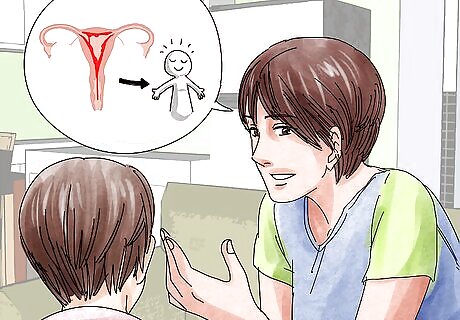
Talk about how the body cleans itself. For young children, you can talk about how the body cleans itself. Say, “A major part of the body is cleaning from the inside out, like when you go pee or poo, or when you blow your nose. When kids get older, their bodies start cleaning in a new way. Sometimes people use special things to help their bodies be clean.”
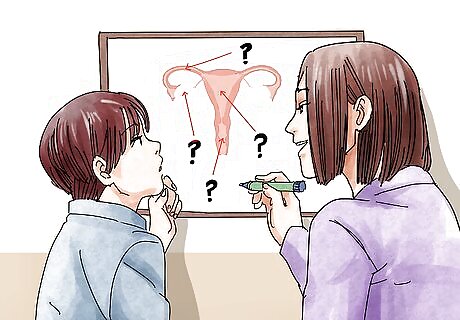
Talk about body parts and functions. Females have different body parts than males. You may want to define terms like “uterus,” “vagina,” or “pregnancy.” Say, “These are all body parts that some kids have. Uterus is a big word that means where a baby grows. Vagina is a word that tells us where babies leave the body, or where blood leaves if there is no baby. Pregnancy is what happens when a baby is growing inside the uterus.”
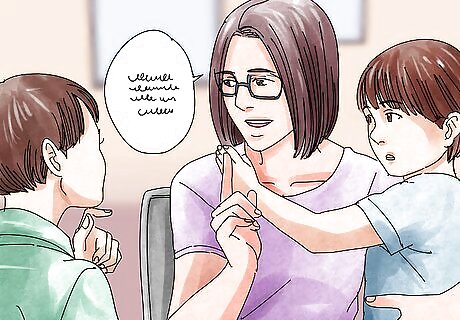
Explain new terminology. With older kids, you may want to introduce common terminology related to menstrual cycles. Clearly explain any newly introduced terminology. Some things you may want to explain include the words “period,” “menstruation,” or “cycle.” You may also want to include slang terms, like “time of the month,” “Aunt Flo,” or “moon/moon cycle,” as these terms may come up at school or within the kid’s social network. Keep your answers simple. If explaining the word period, say, “A period is something at the end of a sentence. But it can also mean the time each month when a female body cleans itself from the inside out. It’s a word that sums up a process that happens in a female body.”
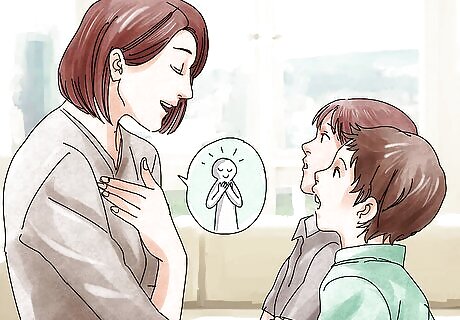
Teach your kids to treat menstruation with respect. Clearly communicate that there is nothing “wrong” with menstrual blood. It is not embarrassing, gross, dirty, or shameful. If your children know that another kid is menstruating, tell them to treat the kid with respect and not to tease them or make them feel bad. Say, “If you notice a person has their period or has blood on her clothes, it’s important to treat them with respect. It’s not okay to tease them or make fun of them. Don’t say anything hurtful to them or anyone else. Remember that it’s normal to have a period.” Make sure they know that menstruation is totally normal and healthy.
Teaching Young Children About Development
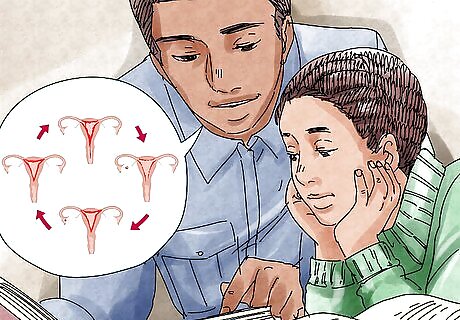
Initiate conversations early on. Don’t put off all explanation of these issues until kids hit puberty and instead, approach topics gradually over time. In addition to making the subject feel taboo, you miss opportunities to correct misinformation. It can be helpful to start developmental dialog about male and female bodies when children are young instead of waiting until puberty. Let kids know that they can come to you with questions about anything to both establish trust in you and guide their understanding of development in a positive way.

Answer curious questions from young children. Young children are extremely inquisitive and observant. They may see a pad in the trash or notice you buying tampons in the grocery store. While you don’t have to go into detail with very young children (3-6 yrs old), address general curiosity as okay and not embarrassing to ask or answer. If a kid asks, “What is that?” in reference to a menstrual product, respond with the name of the object (tampon, pad, menstrual cup, etc). You may follow up your response with, “This is something people use to keep their bodies clean.” As kids mature, they may ask progressively more in-depth questions about the process of menstruation or how babies are made. Use your judgment when giving details so you don’t overwhelm them with information they don't want or need.
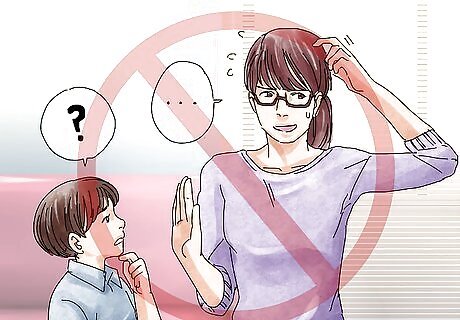
Don’t avoid answering questions. Children have a knack for asking personal or slightly uncomfortable questions in very public places or at a time that may seem inappropriate to adults. If you are asked a question about menstruation, do not say you will talk about it later or at home, since this will give the impression that it’s an embarrassing subject. Even if other people are nearby, casually answer the question. Do your best to answer the question in that moment. If the question caught you off guard or if your answer was not helpful, consider doing a follow-up response later that night.

Tailor your answers to maturity level. Adjust your responses to your child’s developmental level and emotional maturity. Think about what concepts your child can grasp and how to break down explanations into smaller parts. Recognize that talking about menstruation is part of the greater theme of development and sex education. Breaking these discussions into manageable parts over kids’ formative years allows you to build on concepts as maturity and awareness increase. Don’t overcomplicate your answers. Speak simply and avoid using complicated metaphors, especially with young children (such as “Aunt Flo” or “time of the month”).



















Comments
0 comment